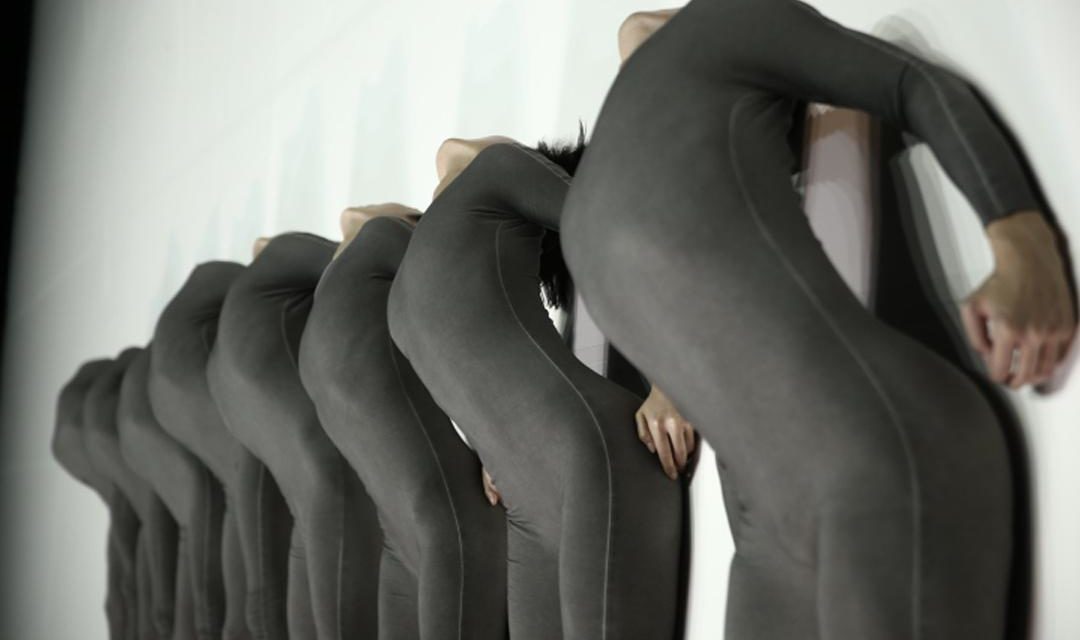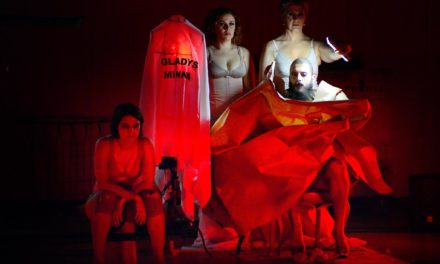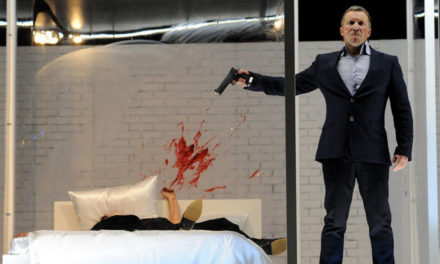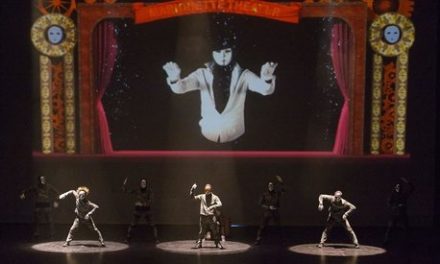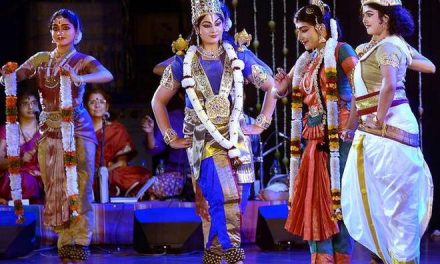Established by the choreographer Tao Ye in 2008, TAO Dance Theatre is an anomaly in the world of Chinese contemporary dance. Their aesthetic goals and style are a departure from traditional perceptions of dance, and their works differ from other postmodern contemporary dance pieces that pursue innovation and interdisciplinarity. TAO’s unconventional style has attracted attention on national and international stages. At the same time, it has also led some skeptics to ask, can this still be called dance?
Dance can easily be associated with beautiful postures, superb technique, harmonious music, overflowing emotions, and moving storylines, but these traditional elements have all been simplified and even eliminated in Tao Ye’s work. In his view, the body and physical movement itself are the essence of dance. Ever since Weight x 3, the first in his Numerical Series [1], he has focused on exploring the body and its physical movement patterns.
TAO Dance Theatre’s Straight Line Trilogy, 6, 7, and 8, which was performed at Shanghai Cultural Plaza in May 2017, is an example of how the troupe has explored spinal motion. In 6, six dancers in skintight black shirts and wide-legged pants stand in a straight line, performing a series of seemingly repetitive movements on loop to the composer Xiao He’s minimalist music. Throughout, the dancers’ hands hang by their sides, and their feet make only the simplest movements. Here, in a departure from dance norms, the movement does not involve the limbs, but stays limited to the torso’s swiveling, bending, swinging, and horizontal movement.
In 7, seven dancers wearing white robes stand in a straight line, repeating a similar set of movements with their torsos. The most significant difference between 6 and 7 is that the latter eliminates all musical accompaniment–in its place are the natural sounds that the dancers make while in motion.
Tao Ye has explained that 6 investigates the possibilities of vertebral movement, while 7 explores the relationship between the body and the voice. In 8, the final installment in the Straight Line Trilogy, the presentation of vertebral movement reaches its apogee. Eight dancers wearing gray bodysuits lie flat on the stage, and again, they repeat a set of movements with their torsos. In a departure from the somewhat two-dimensional presentation of movement when the dancers were upright, every one of the body’s undulations, twists, and turns can be observed more clearly by the audience with the dancers lying down, and the possibilities of how the torso can move becomes even more palpable, although the dancers’ torsos, flattened against the ground, prevent a full view of the body, and movement is limited to spinal motion only.
For the most part, 6 completes the exploration of spinal motion, which 7 builds on by connecting the body’s movement to inhalation, exhalation, and vocal release. 8, through laying the body flat, pushes vertebral movement to the extreme while laying bare the musculoskeletal changes that take place during movement, which can be as minute as the physical changes caused by breathing. All three works are interconnected, each new piece building on what came before. Extremely rational and restrained, they seem more like presentations of research findings than dance performances.
Eliminating narrative and emotional through lines, and even setting aside concepts and subjects, TAO’s works focus solely on the body itself, using ostensibly repetitious movement to further their precise process of exploration. Audiences accustomed to traditional dance performances might find this challenging, and it comes as no surprise that some have questioned and criticized this emphasis on the body as being limited and without a further point. Yet a more meaningful approach would be to trace the roots of TAO’s work and find new ways of interpretation, precisely because they break out of traditional aesthetic frameworks and challenge the everyday experience of spectatorship.
1) A (Re)Turn to the Body
Tao Ye’s focus on the body and its modes of movement is not unfounded. It, in fact, concurs with the turn towards the body in art and philosophy. In traditional Western philosophical theory and some religious theories, the human being is usually divided into two parts: body and consciousness (alternatively known as spirit or soul), with the body considered the lesser of the two. Philosophers dismissed the body’s sensibilities and desires as inferior and animalistic, as an impediment to the mind’s pursuit of freedom and the “chief culprit” responsible for obstructing a rational understanding of truth. Descartes, after prolonged meditation, famously deduced that all physical perceptions could be false. Consequently, only his thoughts could prove his existence. The assertion “I think, therefore I am” completely separates body and soul and comes close to denying the body any significance whatsoever, a situation that took a turn only with Nietzsche. In Nietzsche’s philosophy, the will to power has the supreme status, and all of the human body’s impulses and passions are a Nietzschean confirmation of the will-to-live. The body became the nucleus of Nietzsche’s philosophy, in which the world cannot be understood without using the body as a point of departure. After Nietzsche, philosophers including Heidegger, Barthes, Foucault, Husserl, Merleau-Ponty, and anthropologists such as Durkheim and Bourdieu all included the body in their discussions, bringing the long-obscured body back into public view where it could exist without shame.
https://youtu.be/6vjd32-HNqE%5D
Corresponding with the bodily turn in philosophy, art also began paying more attention to the body. The performative turn in theatre redirected attention towards the excavation of physical energy, instead of treating the written text as an absolute center. Artaud’s Theatre of Cruelty, Stanislavsky’s Method of Physical Action, Meyerhold’s Biomechanics, and Grotowski’s pursuit of the holy actor are all examples.
In dance, the renewed emphasis on the body is not so much a turn as a return. For dance, one of the oldest art forms, the body has been central from the very beginning. However, due to the aforementioned longtime dismissal of the body, dance was historically only regarded as an aesthetically pleasing form of entertainment, making it a challenge for the art form to progress to a higher aesthetic level. There have been continued attempts to reform dance throughout history by exploring elements such as meter, breath, movement, and space, or by adding dramatic elements such as language and narration to create stories in which dancers play specific roles. Around the 1900s, modern dance emerged, advocating freedom and expression of the soul, and the explorations of experimental dance burgeoned. By the time Tanztheater was created by the German choreographer Pina Bausch in the 1970s, exerting a profound influence on modern dance reform, dance had become hard to distinguish from theatre, and Tanztheater could rightly be viewed as a form of postdramatic theatre.
In the postmodern context, crossover and the merging of various artistic forms have become the new normal, promoting the development of new artistic forms on the one hand, and triggering internal anxieties for traditional art forms on the other. Just as theatre, challenged by the film and television industries, turned to anthropological approaches to explore its original ritualistic characteristics, for dance, besieged by theatre, it also became necessary to reexamine the potential of the body through exploring physical techniques.
2) The Body, Simple in the Extreme
Tao Ye is not the first or the only person to return to the excavation and research of the body. Many contemporary choreographers research bodily movement, distill a purely physical vocabulary, and develop unique physical training methods. However, while most choreographers are only using their research as a means and a tool to develop the dancers’ physical skills, research is Tao Ye’s ultimate goal, and its results go beyond the rehearsal room to ascend the stage.
TAO Dance Theatre’s works are centered on the body and physical movement, and their simplicity is the most profound impression they leave. This may sound unremarkable or even banal, but works like TAO’s are a true rarity in today’s modern dance scene. They treat the body as their only subject and try their best to eliminate the influence of all other elements so as to achieve a state of the utmost simplicity.
https://youtu.be/m64OI1KIkJo%5D
To begin, TAO’s pursuit of simplicity is apparent from their pared-down themes. Tao Ye firmly anchors the central themes of TAO’s works in the body and its physical movement, deliberately suppressing the expression of other themes or meanings external to or even derived from (but not intrinsic to) the body. Likewise, at the core of Tao Ye’s choreography of movement is the logic of physical movement. He doesn’t seek symbolic significance in movement, and, as his insistence on using numbers to name the works makes evident, nor does he intentionally guide the audience to branch out their thoughts beyond the given theme.
The lengths to which Tao Ye has gone as a creative artist requires courage, since the audience’s strong desire to find themes and seek meaning can make it difficult for them to accept works without further meaning. The majority of contemporary dance pieces satisfy the audience’s desire for meaning by maintaining an understandable conceptual core even as these works focused on the body remove narrative and emotional through lines. Moon Water (1998), by Taiwan’s Cloud Gate Dance Theatre, interprets the Buddhist proverb that inspired it, “Flowers in a mirror and moon on the water are both illusive.” Cursive (2001) revolves around the central idea of calligraphy, creating dance out of the image of the body as ink brush. Rice (2013) is a vivid display of agrarian civilization. Other dance companies that have incorporated elements of theatre or physical theatre companies have expressed an even stronger and more evident desire for meaning in their works. Active groups in recent years, such as the performance artist duo Xiao Ke × Zi Han, director Li Ning’s J-Town Physical Guerrillas, and documentary filmmaker Wu Wenguang and choreographer Wen Hui’s Living Dance Studio have all tried to draw attention to social issues and critique them through dance. It becomes apparent that although most contemporary dance works put the body center stage, the body itself is not at the center of their themes or the logic of their choreography. In other words, the body is not the subject of the work but a medium for and carrier of meaning. Choreographers often compose and create around a theme external to the body, and the audience, in its turn, is also accustomed to excavating the meaning behind the body, based on the logic of the choreography. This mode of creating and viewing is understandable, since the body is capable of expressing an inexhaustible range of theme and meanings, and the body, once put on display, will naturally produce meaning. On the other hand, however, we should also recognize the significance of the body and physical movement in and of themselves, and view them as worth exploring–a point of view that proves, at least partially, the significance of Tao Ye’s choice to restrict his subject to the body and physical movement.
Using the body and physical movement as his sole themes, Tao Ye has been able to eliminate extraneous elements from his works in a more thorough and smooth way. In order to direct all of the audience’s attention to the dancer’s body and physical movements, he has excised as many elements onstage as possible, and his pursuit of minimalism has further thrown the aesthetic style of TAO Dance Theatre into relief.
Many contemporary dance works today are seeking interdisciplinary collaboration, incorporating installation art, using multimedia technologies, and even creating 3D dance theatre in an effort to generate more impactful visual effects onstage. In contrast, TAO Dance Theatre’s stage designs are simple to the extreme, with an empty stage devoid of extraneous props or equipment. Their extremely restrained lighting designs only shift between light and shadow or serve to delineate the stage space. The dancers are dressed in plain outfits of a monochromatic, unassuming palette, and their makeup and hair are just as simple.
Music, an element often so intimately wedded to dance, has likewise been reduced time and again in Tao Ye’s works. Tao Ye’s choreography departs from the norm: it doesn’t begin with music. He doesn’t use a musical structure as a basis for arranging movement or use music to call forth emotions and heighten the atmosphere. From having his dancers perform to minimalist music, to solely using the sounds of physical movement and the dancers breathing to create rhythm in 7, Tao Ye’s paring down of musical elements may well continue.
With scenography simplified to the utmost degree, the audience’s only source of sensory impact lies in the bodies of the dancers, which are continually in motion. But even those bodies and their movement are in themselves still being simplified even further. Fully clothed, mostly covered, the dancers’ bodies are deliberately degendered; the dancers themselves display no emotion and leave no hint for the audience to guess at their feelings; without physical contact between the dancers, grounds for interpersonal communication can hardly exist. What the audience end up facing are bodies–to be precise, purely physical bodies–stripped of all social identities that offer no clue to the inner workings of emotion and rationality. After being simplified by Tao Ye, all that remains of physical motion is a series of distilled movements of the torso, seemingly repeated without end. At this stage, it may be said that simplification has truly been pushed to the extreme.
Dance pieces that emphasize physical technique generally use basic movements or a set of distilled movements as the foundation for further development. But few are like Tao Ye, with his minimalist approach that gradually effects the subtlest changes to movements while repeating them. There are similarities between the works of TAO Dance Theatre and those of Taiwanese choreographer Lin Wen-Chung’s company, WCdance. Lin Wen-Chung has also developed a stylistically minimalist logic of physical movement with fluidity as its core concept, but his composition of movement is far more complicated than Tao Ye’s. In Lin Wen-Chung’s Panta Rhei (2016), dancers constantly rotated their joints to show the many shapes and forms of flowing water, their movements in perfect harmony with the theme of shift and change. Although visually more interesting and more accessible than TAO Dance Theatre’s works, Panta Rhei obviously has more reservations about the pursuit of minimalist aesthetics.
Stripping a production of all extraneous stage elements gives the audience no choice but to stare at the bodies onstage, a situation created by Tao Ye’s original intention of returning to the body itself. However, a minimalist stage stripped of everything apart from bodies and movement might more or less confuse the audience. One might ask: What do works like these mean? And what breakthroughs can all this research into purely physical movement bring?
3) The Body: The Key to a Hidden World
Again, it needs to be clarified that TAO Dance Theatre doesn’t focus on rationally understanding the metaphorical body with all its external meanings. They don’t see the body as a symbol of passion and freedom, or as the embodiment of oppression and discipline, both common motifs onstage. Rather, TAO’s bodies launch into motion from the moment they are perceived by the senses. They are a conglomeration of the senses, linked to nature, pure and alive. If we can acquire understandings and knowledge of the world from performances that center on stories and emotions, and even undergo sublimation and catharsis in the process, it is perhaps equally possible to arrive at different experiences and understandings through the pure physical movement in TAO’s work.
Returning to the body means not only directing our gaze towards the body but also understanding and interpreting the world from a physical point of view. As we focus on the body with singular attention, a hidden world reveals itself. Everyone has a body, but we are not used to looking at the physical body carefully. Nor do we really understand our own bodies. In a sense, no one can truly understand their own body because we’re unable to look directly at our own bodies–looking at the body in the mirror is only seeing its surface appearance. In contrast, through watching others and observing their actions, we can find in the body of others what we cannot see in our own. As Merleau-Ponty states,
“Man is a mirror for man. Mirrors . . . convert . . . myself into another, and another into myself.” [2]
His argument enables the body to be discovered through seeing, and it is through mutual watching that people discover, validate, and connect to each other. Moreover, Merleau-Ponty observes,
“I have only to see something to know how to reach it and deal with it.” [3]
That is to say, through the mediation of the viewer’s gaze, dancers moving on stage could affect the viewer. At the scene of a live performance, the audience may feel their body responding and becoming part of the field of motion created by the dancers, feel the change in rhythm, or sense the dancers’ muscles flex and tauten. This sense of departure from daily life may not be an illusion but rather a kind of physical awakening that could lead us to open up a hidden world.
Self-consciousness begins with distinguishing one’s own body from the bodies of others and recognizing that we have separate bodies. It also marks the beginning of the separation between Self and Other. Our ever-growing self-consciousness allows us to grow into independent people while it proceeds to sever the connections between people and those between the self and the world. In the world we live in, everything seems to be disjointed, separate, and isolated. But does my body have to be completely different from and incompatible with other bodies? When I look at the body of another and realize that we all have a body, separate yet so similar–since we’re all living people with living, moving bodies–it becomes possible for the severed connection between us to rekindle. The bond that connects us comes from nature, and nature is filled with the flowing vitality of the body that connects every isolated individual and connects each of them to the equally vibrant world of nature. It becomes possible for us to discover or rather return to a hidden world. Despite once being regarded as primitive and barbaric, it can truly nurture our lives and provides us with a homeland free from loneliness and anxiety.
TAO’s continuous and repeated movements onstage imitate the eternal flow of the force of life. The body in motion, responding to the call of that vital force, has opened the door to a vibrant world. Trying to find meaning onstage becomes futile and meaningless because vitality cannot be confirmed on a rational level. The ripples of the force of life pass from stage to audience, who are expected to perceive and respond. We would do well to watch closely, and then embrace that force with our own bodies.
Not too long ago, human beings advanced at an astonishing rate under the light of Rationalism and achieved brilliant results in science, philosophy, and art. Today, it is a breakthrough and a return for us to open up this once-hidden world of life, this realm of the body and perception. Passive viewing is not the ultimate goal, and it cannot substitute real action. However, the possibility of awakening the body, brought about by spectatorship, may very well provide us with an alternative path towards increased agency for theatre audiences that includes not being confined to rational reflection and criticism while triggering an awakening and release for the body and the consciousness. When TAO Dance Theatre presents the body in motion onstage, stripped down to its essence, in an extremely simple and pure way, it is issuing not a deliberate provocation of tradition but something more akin to an invitation for the viewer to use their body to engage with the dancers’ bodies, and to respond, with their senses, to the sensory world onstage. If we can lower the wary walls of rationality and accept this sincere invitation, it then becomes possible for us to reconnect with a world full of vitality and reap the reward of an extraordinary experience in the theatre.
Notes:
[1] TAO’s Numerical Series are all named after the number of dancers in the piece. The series contains eight works as of 2018: Weight x 3, 2, 4, 5, 6, 7, 8, and 9. In an interview, Tao Ye explained that the troupe named the works with numbers to prevent the audience from forming preconceived notions that would limit their understanding of them.
[2] Maurice Merleau-Ponty. Eye And Mind, trans. Yang Dachun, Commercial Press, 2007, p. 24. [The English translation here cites Carleton Dallery’s translation of “Eye and Mind” from The Primacy Of Perception, by Maurice Merleau-Ponty, ed. James M. Edie, Northwestern University Press, 1964, p168.]
[3] Ibid., p. 16. [Ibid., p. 162.]
Translator’s Note:
All Chinese names in this essay follow the Chinese format of [Surname, First name].
About the Author:
Zhu Yue is a freelance writer and critic. She graduated with a BA in Philosophy from Sun Yat-sen University and received an MFA in Theatre Theory and Criticism from Nanjing University in China. You can reach her at mozita_zy@126.com.
About the Translator:
Marta Bianco graduated with honors in Chinese Language and Literature at University of Naples “L’Orientale” with a thesis in contemporary Chinese theatre. She attended Shakespearean workshops with Roberto Del Gaudio and acted in Italian and Chinese for director Lorenzo Montanini’s experimental bilingual theatre project at “L’Orientale.” She also studied at the Communication University of China and the Central Academy of Drama in Beijing for a year. She is collaborating with Beijing-based Mamonahi Theatre Dance Company, assisting with production and management. In October 2018, she will begin her master’s program in Oriental and African Languages and Literatures at University of Naples “L’Orientale.”
The original Chinese version of this article was published in the July 2017 (No. 20) issue of Stage And Screen Reviews. This translation has been published as part of TheTheatreTimes.com’s Chinese and Sinophone Theatre Criticism Translation Initiative, edited by Yan Chen.
This post was written by the author in their personal capacity.The opinions expressed in this article are the author’s own and do not reflect the view of The Theatre Times, their staff or collaborators.
This post was written by Yue Zhu.
The views expressed here belong to the author and do not necessarily reflect our views and opinions.

